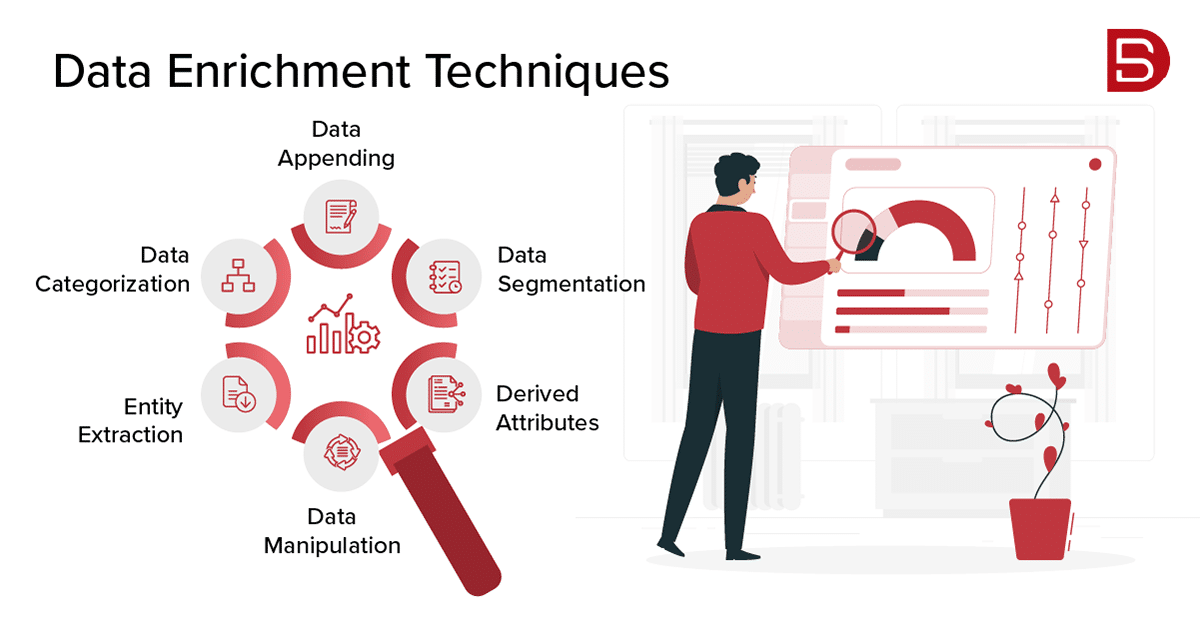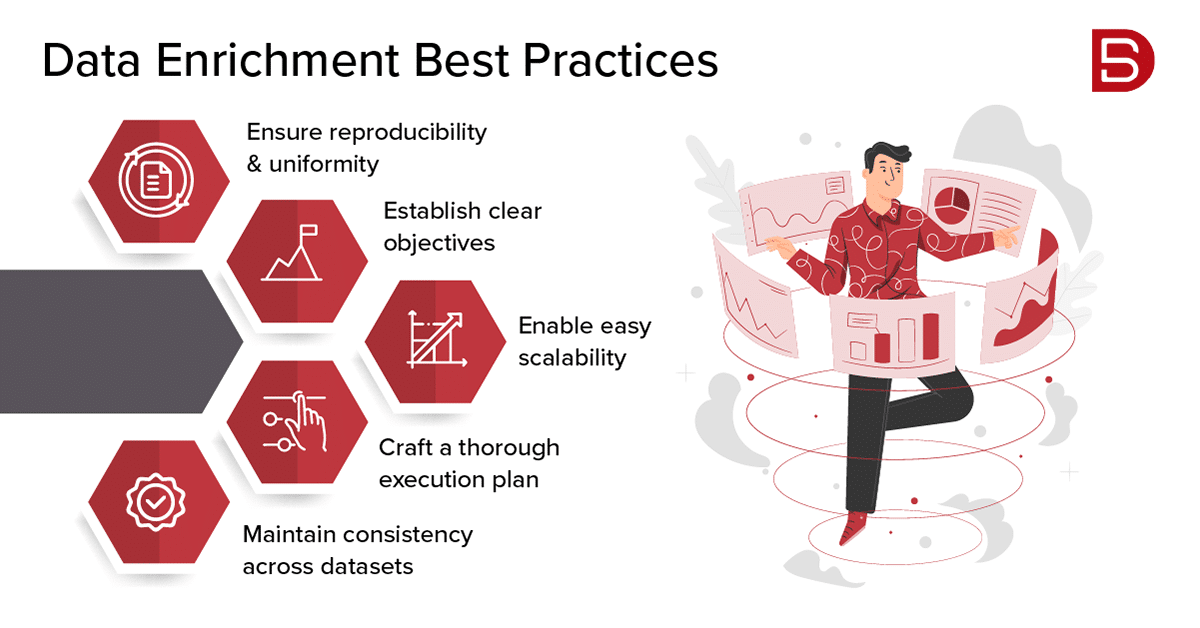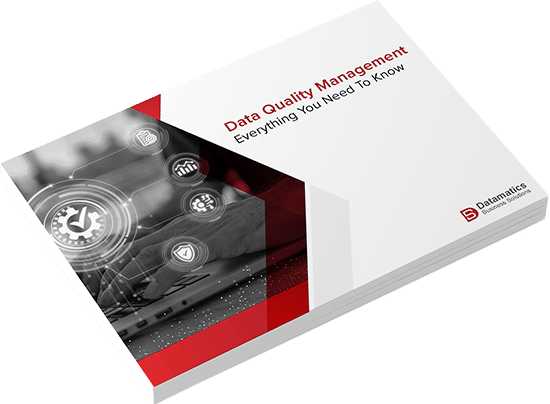In the high-stakes world of B2B sales, it’s not just about convincing someone to buy a product; it’s more similar to negotiating a strategic partnership. Today, with intense competition, your success depends on a smart and personalized approach.
Data is the engine that drives the B2B customer journey. But relying solely on your own data won’t give you the edge you need. When you and your competitors have access to the same volunteered data, you’re on a level playing field. To gain a deeper understanding and a competitive edge, you can turn to data enrichment. It’s the key to getting ahead.
Data enrichment stands out as a crucial technique for enhancing the worth of your data. It goes beyond merely extending your data – it refines and elevates it. Here’s an example: you can take basic address data and supercharge it by including socioeconomic demographic information like average income, household size, and population demographics, all linked to postal codes or ZIP codes.
By enriching your B2B data, you unlock a deeper understanding of your client base and potential target customers. It helps you reveal a clearer and more intricate picture of your audience.
Table of Contents
Strategic Advantages of Data Enrichment for B2B Marketers
Data enrichment has a wide range of potential applications, but there are several challenges specific to B2B marketing that data enrichment can potentially solve:
Advanced Segmentation
This process involves dividing your audience into more focused interest groups, which can significantly boost the effectiveness of your marketing efforts. By leveraging enriched data, you can expand your client base and enhance your segmentation options.
Imagine you want to send marketing materials to members of different trade organizations, but the specific field identifying these organizations isn’t on your landing pages or lead capture forms. In this case, using social data enrichment can help you gather this information from platforms like LinkedIn and include those leads in your targeted segments. Having fewer required form fields can encourage more people to submit forms, and data enrichment can help fill in missing information, so you don’t have to add more fields to your forms.
Improved Lead Scoring
This is a valuable tool for your sales team to prioritize their efforts effectively. However, there’s a valid concern about whether lead scoring is worth the time and resources, especially when it becomes more of an art than a science. This challenge becomes even more significant when dealing with limited information. It’s relatively straightforward to consistently evaluate detailed customer profiles, but assessing incomplete profiles can, at best, be an educated guess.
Enriched data can be a turning point in this scenario. It has the power to transform a customer profile from “incomplete” to “in-depth,” allowing for more meaningful and precise lead scoring. By working collaboratively, your sales and marketing teams can identify the critical data points essential for lead scoring, pinpointing areas where you should focus on improving your lead data quality.
Personalization
Customers are aware that their data is shared, and they expect companies genuinely interested in their business to invest in personalized, thoughtful approaches, even if it involves using their data for marketing purposes. This goes beyond merely exceeding expectations in B2B. In this digital era, the ability to capture the interest of decision-makers and demonstrate a deep understanding of their challenges and objectives can make or break deals.
Data enrichment is a valuable tool in the arsenal of B2B marketers. Through the use of machine learning algorithms, marketers can employ data enrichment services early in the sales process to create tailored messages and experiences for clients, enhancing customization and building stronger connections.
Competitive Edge
Leveraging enriched data offers a competitive edge by enabling precise targeting, personalized content, and effective lead scoring. This advantage ensures that marketing efforts resonate with the right audience, increasing conversion rates and customer satisfaction. Enriched data also provides valuable insights into customer behavior, competitive intelligence, and real-time adaptability, allowing businesses to stay ahead of the competition and make informed decisions. Ultimately, this data-driven approach enhances customer retention, helping brands stand out and succeed in a crowded marketplace. You can always take this a step further by partnering with a B2B data provider. Collaborating with a reputable data provider can further enhance your data-driven approach. They can offer access to high-quality, up-to-date data, which is crucial for accurate targeting and effective decision-making.
Unlocking the Power of Data Enrichment: 6 Effective Techniques
1. Data Appending
This is the process of adding or attaching additional information or data to an existing dataset. This additional data can come from various sources, both internal and external, and is used to enrich and enhance the original dataset.
For instance, B2B companies typically have their customer data in their CRM, sales data in financial system, and campaign data in the marketing platform. Individually, each system provides some insights, but they don’t give you the full picture. Data appending helps combine all these data sources to create a unified, supercharged dataset.
With this, you can merge customer profiles, purchase history, and campaign engagement into a single, comprehensive view of your customers. This means you can personalize your marketing campaigns with pinpoint accuracy, sending tailored promotions to the right people at the right time.
But it doesn’t stop there. You can also enrich your data by adding external information. For instance, incorporating geospatial data can help you understand where your customers are located, allowing you to target local promotions effectively. You can even factor in weather data to adjust your marketing strategies based on local weather conditions.
Data append helps B2B marketers craft the perfect message by combining all the ingredients – your customer data, external insights, and the right timing – to create a winning campaign that resonates with your audience and drives sales.
2. Data Segmentation
Data Segmentation is the process of categorizing a data object, such as a customer, product, or location, into groups based on shared, predefined attributes. This segmentation enhances the accuracy of classification and description of the object.
For instance, customer segmentation involves several approaches:
- Demographic Segmentation: This method categorizes customers based on attributes like gender, age, occupation, marital status, and income.
- Geographic Segmentation: It divides customers based on their location, which could be at the national, state, or city level. Local businesses may even use specific counties or municipalities for segmentation.
- Technographic Segmentation: This approach relies on customers’ preferred technology, software, and mobile devices.
- Psychographic Segmentation: Here, segmentation is based on personal attitudes, values, hobbies, or personality traits.
- Behavioral Segmentation: This method categorizes customers based on their actions or inactions, spending patterns, feature usage, session frequency, browsing history, average order value, and more.
If the available data allows, you can create your own custom segmentation by defining calculated fields in either an ETL (Extract, Transform, Load) process or a metadata layer. This enables you to tailor the segmentation to specific data characteristics and business needs.
3. Derived Attributes
These are fields that you can create from one or more existing fields, but they are not originally present in the initial data collection. For example, although you might not have an ‘Age’ field in your data, you can calculate it based on a ‘date of birth’ variable. Derived attributes are incredibly useful because they often involve calculations that are repeatedly used during data analysis.
Examples of derived attributes include:
- Counter Fields: These can be generated based on a unique ID within the dataset, making aggregations and calculations straightforward.
- Date Time Conversions: Extracting information like the day of the week, month, quarter, etc., from a date field.
- Time Between: Calculating the time elapsed using date and time fields, such as response times for tickets.
- Dimensional Counts: Creating additional counter fields for specific categories by counting values in an existing field, like counts for different types of offenses, making it easier for comparative analysis.
- Higher Order Classifications: Deriving attributes like ‘Product Category’ from an existing Product’ field or ‘Age band’ from age values.
Additionally, advanced derived attributes can be generated by data science models and simulations. For example, these models can calculate client churn risk or propensity to spend, providing valuable insights for business decisions.
4. Data Manipulation
This involves the practice of replacing missing or inconsistent data within fields. Estimating these missing values contributes to a more precise data analysis, preventing the inclusion of missing values as zeros, which could distort aggregation results.
For instance, if the value of an order is unknown, it can be approximated by considering the customer’s historical purchases or the specific assortment of products within the order. This approach helps maintain the integrity of data analysis by addressing gaps in the dataset.
5. Entity Extraction
You know when you’ve got a bunch of messy data, and you’re trying to find the good stuff in there? Well, that’s where entity extraction comes in. It is the process of extracting structured and meaningful information from unstructured or semi-structured data. By applying entity extraction techniques, you can identify and categorize entities like individuals, places, organizations, and abstract concepts. Additionally, it helps recognize numerical expressions, such as dates, times, monetary values, and phone numbers.
6. Data Categorization
It is the key to transforming unstructured chaos into organized clarity. It helps in giving structure to a world of information.
Here are two important aspects of it:
- Sentiment Analysis: It is a way to understand the feelings behind text. It helps determine if customer feedback is positive, negative, or somewhere in between, allowing you to read in between the lines.
- Topication: It finds the main theme in a piece of text, whether it’s about sports, politics, or something else entirely, allowing you uncover the big picture.
So, whether you want to know the mood in text or dive deep into its core meaning, data categorization is your tool.
Elevate Your Data Enrichment Game: Best Practices
Data enrichment isn’t usually a one-and-done task. Especially in an analytics environment where fresh data keeps pouring in, you’ll find yourself revisiting the enrichment process regularly. This ongoing effort is essential to ensure that your data stays top-notch and aligned with your specific goals.
To make sure you’re on the right track and maintain data quality, there are several best practices you should follow. These include:
Ensure Reproducibility & Uniformity
Every data enrichment operation should be capable of being reproduced consistently, yielding the same desired outcomes each time it’s executed. To achieve this, your processes should adhere to well-defined rules. This ensures that whenever you rerun a process, you can have confidence that the results will remain steadfast and uniform.
Establish Clear Objectives
For each data enrichment operation, it’s essential to establish clear evaluation criteria. You should be able to assess whether the process has achieved its intended objectives and has functioned as planned. By comparing recent results with those of previous tasks, you can confirm that the outcomes align with your expectations. This transparency is crucial for effective data enrichment.
Ensure Easy Scalability
Each data enrichment operation should be designed with scalability in mind. This means that your resources, timelines, and costs should be adaptable to accommodate the growth of your data over time. If your data processes are entirely manual, you might encounter limitations in processing capacity and increased expenses as your data expands. To avoid these challenges, it’s advisable to automate your processes as much as possible, utilizing infrastructure that can easily scale to meet your evolving needs.
Craft a Thorough Execution Plan
Every data enrichment task should be executed in a manner that ensures the results align with the qualities of the input data. This necessitates thorough planning, including accounting for all possible outcomes, even scenarios where the outcome is “unknown.” By maintaining completeness when handling new input data, you can have confidence that the results of the enrichment process will consistently meet your reliability standards.
Maintain Consistency Across Datasets
Data enrichment activities should possess adaptability, allowing them to be applied to various datasets. The processes you establish should ideally be reusable across different datasets, ensuring consistency in results. For instance, extracting the day of the week from any date field should follow the same method. This approach maintains uniformity in outcomes and keeps your business rules consistent across different areas of your data domain.
Wrapping Up
Data Enrichment comes in various forms, but its main goal is always the same: to make data more valuable. Depending on a business’s goals, different types of Data Enrichment can be used, making it a versatile tool in the data-driven consumer industry. This flexibility has made it a powerful asset in this field.
However, in today’s business landscape, many organizations are dealing with an immense volume of data that often comes with a dynamic structure. Building a data pipeline from the ground up and handling all the data enrichment operations for such extensive datasets can be intricate and resource intensive. This is where the outsourcing data enrichment services proves to be invaluable. Write to us at [email protected] to draw precise customer insights and channel your marketing efforts effectively with our B2B data enrichment services.




